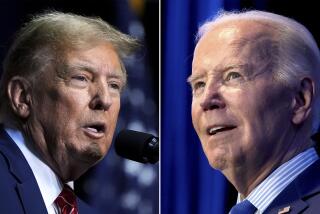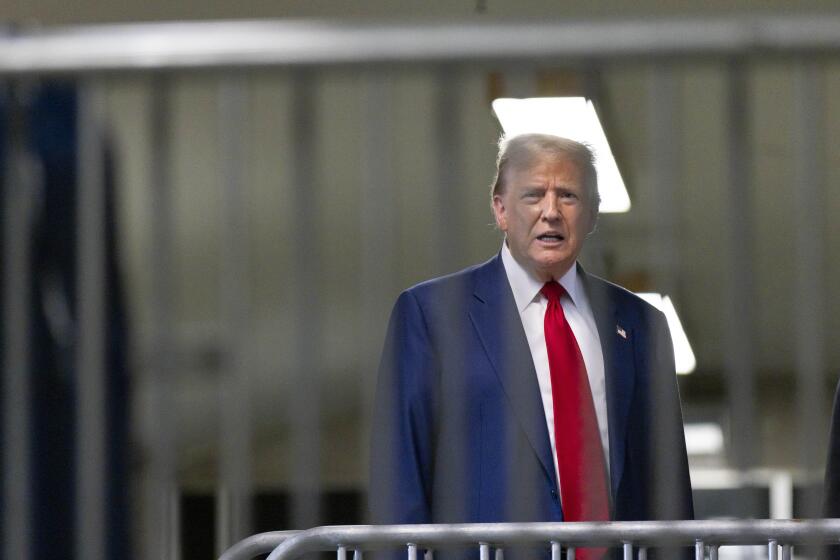What polls really tell us about the state of the presidential race
With Labor Day almost here, the traditional start of the campaign season, a raft of new polls has arrived, giving insights into which candidates have the lead but also why and what Americans think about the issues the country faces.
It’s commonplace for people to say they don’t trust polls or don’t like them. Certainly some politicians misuse them to substitute numbers for principles. And polls are, of course, no more perfect than any other human invention.
But despite much carping to the contrary, polls have a remarkably good record of accuracy in American elections — even in 2016. More important, polling is the one element of the political process that allows us to hear directly what voters from all parts of the country and all walks of life have to say. So, let’s dive in.
ONE CANDIDATE RISING
The Democratic race has a fairly consistent picture, with three main elements:
First, the main candidates remain in the early stage of the race. Only about 1 in 8 Democratic voters have firmly made up their minds, according to an NBC/Wall Street Journal poll released earlier this summer. History suggests that won’t change a lot until late fall.
That doesn’t mean the race is wide open, however. Whether a poll asks voters for their one top choice or to name all the candidates they are considering, a clear top tier emerges. And overwhelmingly, 81% in a recent poll by YouGov for the Economist, Democratic voters say they’re happy with their choices: There’s no hunger for some other option.
That’s a big reason we’ve started to see lower-ranked candidates dropping out, like Sen. Kirsten Gillibrand of New York, who quit the race Wednesday.
Second, former Vice President Joe Biden remains ahead of the pack, but not by huge margin. Biden has, on average, just short of 30% of the vote among Democrats nationwide. That’s been true most of the summer.
He’s a front-runner with significant weaknesses, as Seema Mehta and Janet Hook wrote.
Third, among the rest, only Sen. Elizabeth Warren has shown sustained ability to expand her support. In May, Biden had more than 40% support in polling averages, and Warren’s backing was in the high single digits. Since then, she’s doubled her support while his has dropped. No one else has significantly moved.
The Massachusetts senator now is more or less tied with Sen. Bernie Sanders in second place in polling averages. Others, including Sen. Kamala Harris and South Bend, Ind., Mayor Pete Buttigieg, have had moments. But those have faded.
Because Warren’s support has grown, and Sanders’ has not, many Democratic professionals think a Biden-Warren contest could be the last chapter in this year’s race, as Hook reported. Plenty of time remains for someone else to make a move, but for now, let’s look at where those two stand.
WHO SUPPORTS WHOM?
Biden consistently does better among self-described moderates. Warren and Sanders divide up self-described liberals.
The former vice president also does well among older voters. In the Economist/YouGov survey, for example, Biden got only 6% support among voters ages 18-29, but 40% among those 65 or older. Sanders has the opposite picture, with a third of the vote among 18-29-year-olds, but only 2% among his fellow senior citizens.
Older voters have a much better record of showing up for primaries than younger voters do.
Warren gets pretty even support across age groups. Her big strength comes from liberal whites who have taken a keen interest in the race.
In this week’s poll from Quinnipiac University in Connecticut, for example, Warren nearly tied Biden among voters nationwide who said they were paying “a lot” of attention to the race.
Sanders, by contrast, got only 1% among that group. His support came from people who said they were paying “some” or no attention. That’s another reason for skepticism about his long-term standing: A large portion of his support may simply be name recognition among people who aren’t likely to show up to vote.
Warren’s big challenge is a shortage of support from African American voters and non-college-educated whites. Biden got nearly half the black vote in the Quinnipiac poll, for example. Warren was at 10%, essentially tied with Sanders and Harris. But among college-educated whites, Warren and Biden were tied.
Warren has spent the spring and summer building an impressive base among the college-educated white liberals who are among the Democratic Party’s most motivated voters. They’re not a majority, though. The challenge for her now is whether she can continue her rise by expanding beyond that group. The outcome of the primary contest could turn on the answer.
TRUMP VULNERABLE, BUT ...
What of the general election?
Reelection races almost always become referendums on the incumbent, and right now, Trump loses that contest with himself. Almost throughout his presidency, about 4 in 10 Americans have approved of the job he’s doing, and the majority has disapproved, with a handful of people saying they’re unsure. His job approval has sometimes ticked above 40%, but never by much.
The Economist/YouGov survey asked how often people support Trump’s policies. Only 15% said they did “all the time” — that’s Trump’s hard-core base. Another 22% said they backed him most of the time. But 46% said they opposed his policies, with 27% saying they opposed him all the time. Just short of 1 in 10 people described their backing of Trump’s policies as 50/50.
One way to think about Trump’s prospects is that to win reelection, he needs to hold all those who say they support him at least most of the time and persuade about 9 out of 10 of those 50-50 voters.
But Trump has another problem: In several polls that have asked hypothetical head-to-head matchups, the share of Americans who say they would vote for him sits a few points below his job approval rating. In the most recent Fox news poll, for example, 43% of voters said they approved of his job performance, but only 39% said they’d back him for reelection.
Trump has railed against that poll — and Fox in general — for the past two weeks, as Stephen Battaglio wrote. The network is “no longer working for us,” Trump said on Twitter.
Doing worse on head-to-head matchups than on job approval is unusual. Typically, incumbent presidents get the benefit of the doubt from some voters and do slightly better than their job approval level. Trump’s failure to do so reflects the dislike that many voters have for his personality and style.
In the Economist/YouGov poll, only 21% said they would use the word “honest” to describe Trump, and 28% would use “intelligent.” But 59% would use “arrogant” and 42% “racist.”
In the Quinnipiac poll, voters by 2-1 said Trump is “doing more to divide the country” than to unite it. The share saying he was uniting the country — never particularly high — was at the lowest point the poll has measured, 30%.
In both the Fox and Quinnipiac polls, Trump lost hypothetical matchups against each of the top Democrats, not getting more than 40% of the vote. Biden did slightly better against Trump than some of the others did, but not by significant margins.
Notably, Trump loses white women by double-digit margins in those theoretical matchups. Trump carried white women by two points in 2016, 47%-45%, according to a detailed study by the Pew Research Center, so trailing among them now is a very bad sign for him.
Hypothetical matchups are just that, of course. We don’t know how the eventual Democratic candidate will fare after a yearlong campaign. But Trump has yet another cause for worry: Voters’ concern about the economy has grown.
The economy has been the president’s strongest point — his ratings for handling it have consistently topped his overall job approval. But now, Quinnipiac finds that 37% of voters say they think the economy is getting worse, up from 23% who believed that in June and 16%-21% who said so through most of 2017 and 2018.
The share who say Trump’s policies are hurting the economy is also up, to about 4 in 10.
Can Trump win again? Sure, he did it once, after all. But there’s no question he’s starting off in a deep hole, and his reelection will likely depend on whether he can pull the Democratic nominee down into it with him.
TWO MUST-READS FROM THIS WEEK
One of Warren’s strengths has been her ability to make complex policy ideas accessible to voters. Where did she learn that? As Noah Bierman wrote, long before Warren got into elective politics, she was appearing on daytime TV, where, among other things, she doled out advice for Dr. Phil. In that one part of her life, she has some similarities to the former TV celebrity now in the White House.
Remain-in-Mexico has been the administration’s chief policy to try reduce the number of people claiming asylum in the U.S. Molly O’Toole took a deeply reported look at how that policy is working, finding significant evidence that the administration may be violating the law by denying migrants their due-process rights.
To take just one example: When they force migrants to stay on the Mexican side of the border, officials have given them an (800) number to call for information about when they’re due in court. The number can only be called from within the U.S.
TRUMP AT THE G-7
The president returned to Washington from the G-7 summit in France in a sulky mood. As Eli Stokols wrote, he lashed out about bedbugs and nuking hurricanes, disputing press reports that the former had been found at his Doral resort and that he had ever talked about the latter.
As he said in Europe, he would like the next G-7, which the U.S. is set to host, to be held at the Doral. He implausibly insisted that he wouldn’t profit and claimed the presidency has cost him billions, Alexa Diaz reported.
On substance, he said he was willing to negotiate with Iran and doesn’t want to force leadership change there, a position that puts him at odds with his national security adviser, John Bolton, and Secretary of State Mike Pompeo, Stokols and Chris Megerian wrote.
Allies’ doubts over Trump’s trade war with China dominated much of the rest of the G-7 meeting. The day before heading to France, Trump raised tariffs on China and threatened the Fed chairman. Markets tumbled. Over the next several days, Trump tacked the other direction, praising the Chinese.
“Sorry, it’s the way I negotiate,” he said when asked about the gyrations.
ON THE TRAIL
Billionaire presidential candidate Tom Steyer released his tax returns with key omissions, Mehta wrote. Steyer did not release details of his investments that would enable voters to see whether he has, as he said, divested from funds that profit from coal and other fossil fuels.
The returns make clear that Steyer is a very, very wealthy man and probably the richest ever to run, although Trump’s refusal to release his own returns makes that hard to know for sure.
Meantime, as Mark Barabak writes, Beto O’Rourke has chucked the playbook as he tries to reboot his campaign. The move may be too late, but the former Texas congressman is giving it a go.
LOGISTICS
That wraps up this week. Until next time, keep track of all the developments in national politics and the Trump administration on our Politics page and on Twitter @latimespolitics.
Send your comments, suggestions and news tips to politics@latimes.com.
If you like this newsletter, tell your friends to sign up.
david.lauter@latimes.com
More to Read
Get the L.A. Times Politics newsletter
Deeply reported insights into legislation, politics and policy from Sacramento, Washington and beyond. In your inbox three times per week.
You may occasionally receive promotional content from the Los Angeles Times.







